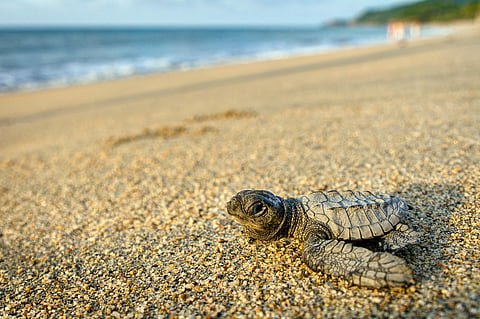
- Destinations
- Experiences
- Stay
- What's new
- Celebrating People
- Responsible Tourism
- CampaignsCampaigns
- Subscribe
- Buy Now

World Turtle Day 2025 | I headed to Mount Lavinia Beach, a popular attraction near the Sri Lankan capital of Colombo, early in the morning. In front of me stretched miles of golden sand, interrupted only by fishermen hauling their nets back to shore and motorboats doing trial runs. I approached one of the motorboat operators and asked if he could take me for a spin as far as he could. Soon, I found myself at a site that had been badly hit by the 2004 Indian Ocean tsunami, which is also home to a local initiative called Our Turtle Conservation Project (OTCP).
Colombo is a tourist's paradise, offering everything from beautiful beaches to rich culture and delicious food. If you have some time to spare or a passion for nature conservation, consider visiting this privately run sea turtle conservation centre, located just beyond the touristy stretch of Mount Lavinia Beach.
Sri Lankan waters are home to five out of the seven turtle species in the world. Our Turtle Conservation Project serves as a hatchery and rehabilitation centre for turtles rescued from fishing nets and vessels in the area. Milan Shirantha Perera, the project leader, works alongside volunteers and local fishermen to ensure the safe hatching, preservation, and release of these turtles.
At the entrance of the project area is a fenced-off patch with small numbered boards sticking out of the sand, marking the sites where turtle eggs are buried. Once the eggs hatch, Milan and his team release the hatchlings into the sea. The turtles in need of medical attention are placed in small tanks at the centre. My heart sank when I saw a couple of Olive Ridley turtles missing their front flippers—victims of fishing net accidents, I was told.
I also met a few rescued hawksbill and loggerhead turtles, as well as some very friendly green turtles. I never thought I'd get the chance to feed crustaceans to turtles. I even tried to pet a hawksbill turtle, but instantly regretted it when the grumpy young one attempted to bite my finger off.
The hatchery is funded by tourist donations, and visitors can even adopt individual turtles financially—essentially sponsoring their rehabilitation. As my Our Turtle Conservation Project tour came to an end, I added a new entry to my bucket list: adopt a turtle.
The sea turtle hatchery of Our Turtle Conservation Project (OTCP) is located south of Mount Lavinia Beach, where the stretch of sand meets the ocean.
Mount Lavinia Beach is approximately 14 km by road from Colombo via Galle Road and St. Rita's Road. A limited number of trains run from Fort Station to Mount Lavinia Station.
The project site is open daily from 8 am to 6 pm.
Mount Lavinia Beach, known for its golden sands and vibrant atmosphere, is a popular spot just 1.3 km away. The Kalutara Bodhiya, a religious site, is about 2.9 km from the OTCP. Additionally, the Colombo National Museum, offering a glimpse into Sri Lanka's history, is located about 2.9 km away.
The best time to visit Our Turtle Conservation Project (OTCP) in Sri Lanka, particularly if you're interested in seeing turtles, is during the nesting season, which generally runs from November to April on the west coast, and February to June on the east coast. This period provides the highest chance of observing nesting females or newly hatched turtles.
Indians travelling to Sri Lanka are advised to apply for an Electronic Travel Authorization (ETA) before arriving in the country. Under this, tourists can enjoy a 30-day free visa period, and a double entry facility is permitted from the date of first arrival to Sri Lanka within 30 days. Applicants who have obtained a free visa and need to stay in Sri Lanka for more than 30 days can apply for an extension by paying the appropriate visa fee.
This story was first published on June 5, 2017; and it has since been updated.
